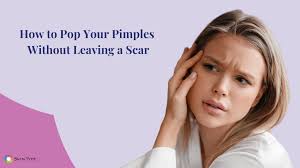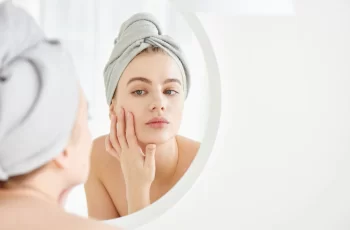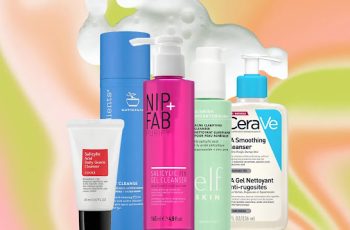
How to Pop a Pimple Correctly Without Leaving a Scar
The best way to get rid of a pimple without scarring is not to pop it and let it heal on its own. However, there are occasions when a zit shows up on your face full of yellow or white pus and you don’t want to leave the house without popping it. We know in this embarrassing situation you will squeeze the pimple- so we will teach you how to pop a pimple with a needle. These instructions on how to pop a pimple can be used on pimples anywhere including the chin, lip, nose, face or back. We will also discuss how to pop a pimple that is not ready to be popped.
To Squeeze or not to squeeze? How to pop pimples without leaving a scar
To Squeeze Or Not To Squeeze- That is the Question
Whether or not you should pop pimples depends upon what type of pimple you have and where you are.
Should you pop pimples?
Do not pop a pimple that does not have a white head. If you do not see yellow or white pus- it is not ready- and there is nothing to pop. You will cause inflammation, push the problem deeper and will worsen the pimple. Popping a pimple that is not ready to be popped will make it take much longer for the pimple to go away and will increase the risk of scarring. Read here to learn what happens when you do not pop a pimple.
Timing and Preparation is Important
Only pop pimples at home because it is best if you can shower first to clean the area before popping.
Never pop pimples without washing your hands and the skin around the pimple first with antibacterial soap. When you pop the pimple it will release bacteria so wash your hands and face (or rea where the pimple was) again after popping pimples.
how to pop a pimple with a needle
Dermatologist Advice on How To Pop a Pimple
5 Steps to Safely Pop a Pimple Without A Needle
If your pimple does have an obvious whitehead, follow these steps to pop it:
Take a hot shower. If a pimple is on the verge of popping on its own, taking a steamy shower is often enough to help it along, without having to physically pop it. If this doesn’t work, however, proceed to the next steps.
Wash your hands to remove dirt, oil and bacteria so that you do not push this debris into the acne lesion and make matters worse.
Wash your face with a salicylic acid cleanser. Salicylic acid removes acne-causing bacteria from your skin, exfoliates and cleans your pores, and reduces inflammation.
Apply gentle pressure around the entire pimple using a medicine dropper or comedone extractor. Never pop a pimple with your fingernails, as this can introduce bacteria and physically damage your skin.It is best to use a sterile medicine dropper or comedone extractor- very gently. If the pimple does not pop after two gentle tries, wait a few hours and try again. Apply gentle pressure around the entire circumference of the pimple using a glass medicine dropper or comedone extractor. It is important to apply equal pressure around the central head of the pimple. (Applying excessive pressure to only one area of the pimple can drive the contents deeper. Equal pressure around the circumference encourages the pus to go out of the skin rather than deeper in the skin.)
Apply a topical antibacterial such as benzoyl peroxide, colloidal silver, or an antibiotic to the popped pimple. These ingredients help to keep bacteria out of the pore so that it can heal properly.
Salicylic acid structure
How To Pop A Pimple With A Needle
The very best way to pop a pimple is with a sterile needle. Put a needle in boiling water to sterile it if you do not have a needle that is already in sterile packaging. The best size of needle to pop a pimple is a 30 gauge needle. You can also use a sewing needle or a safety pin- but make sure they are sterile.
Gently insert the sterile needle in the middle of the head that has yellow or white pus. Very slow and gently. Then follow the 5 steps to pop a pimple above. Do not prick the pimple more than 2 times. If the pimple does not pop- wait and try again in an hour. Or do not pop it at all.
How To Pop A Pimple That Is Not Ready
Pimples are caused by bacteria that gets into the hair follicle and eats the dead skin cells and oil that is lodged in the hair follicle. (Learn more about the stages of pimples here.) As the bacteria eat the dead skin cells and sebum, it releases inflammatory factors that cause inflammation. Immune cells move to the area and surround the bacteria and wall it off. Once the bacteria and debris is surrounded and walled off by the immune cells, a central area of pus forms. Pus is immune cells and inflammatory factors. If you squeeze a pimple before it has walled off the offending bacteria and debris, you interfere with the entire process and prevent the immune system from doing its job. This is why you should never pop a pimple that is not ready. Instead of popping a pimple too soon, follow these instructions to treat a pimple that is not ready.
How To Pop A Pimple With No Head
Blind pimples and Papules Are Not Ready To Pop
Pimples with no head are sometimes called blind pimples. Blind pimples have no eye- or central white pus. Dermatologists call these papules. Never try to pop a blind pimple or papule. It is not ready. You can learn more about the different types of pimples and what happens when you do not pop them here.
It may take 2-3 days for the pimple to go away on its own but it will slowly get smaller and smaller. Picking it will make it take much longer to heal. Just cover it with an acne spot treatment or patch, cover with concealer and try not to touch it.
Benzoyl peroxide vs salicylic acid
How to Pop a Pimple That is Not Ready
Don’t pop a pimple that is not ready. Instead, visit your dermatologist for a steroid injection or try one of these acne spot treatment ingredients:
Benzoyl peroxide 5%
Salicylic acid 2%
Topical steroid such as prescription triamcinolone cream
Topical sulfur
Colloidal silver topically
Tea Tree Oil
Acne spot treatments can be used twice a day on a pimple that is not ready to pop.
How to Get Rid of a Many Pimples Overnight
If you have a sudden break out and it is an emergency because you have an important event, try these steps to help clear skin overnight. Of course it will not completely clear your skin, but in the absence of a dermatology visit, this is the best you can do to clear skin fast. Try these three steps in the evening to try to get rid of pimples overnight. The pimples may come to a head overnight and you can pop them in the morning.
Remember- this is not a long-term solution to acne and you need to get on a acne skin care routine to keep you from having to pop any more pimples!
Wash your face with a salicylic acid cleanser. As noted above, salicylic acid is an excellent cleansing and anti-inflammatory ingredient for acne.
Apply an acne toner such as Element 47 to reduce acne-causing bacteria and oil on your skin even further after washing.
Apply a benzoyl peroxide and hydrocortisone mixture. Combine a 1:1 ratio of these two ingredients and use the mixture to spot-treat problem pimples during your nighttime skincare routine. In the morning, you should notice an improvement in the spot-treated pimples. If they come to a head, follow the instructions above on how to pop a pimple.
What to wash face with before popping a pimple
I recommend using a benzoyl peroxide cleanser before popping a pimple. BP will help decrease bacteria on the skin lowering the risk of infection.
Wash the skin again after popping the pimple to remove bacteria released in the pimple pus. Good BP cleansers are:
PCA Skin BPO 5% Cleanser
Replenix BP 5% Acne Wash
When to See a Professional for Acne
If you have persistent acne that is not going away on its own, don’t resort to constantly popping zits and picking at your skin. It is better to get on the right skin care and prevent acne instead of treating it. You can read here about when to know if its time to see a dermatologist for your pimples. Follow this link to find a board-certified dermatologist or a STS approved skin care specialist who can assess your skin type and unique needs and prescribe appropriate treatment products to clear your acne once and for all.
If you’re not in a pinch to get rid of pimples, it really is best to schedule an appointment to get professional facial extractions instead of taking matters into your own hands. Facial extractions can remove whiteheads, blackheads, and other imperfections such as milia bumps to reveal smooth, bright skin without the risk of damaging your skin further by attempting to pop or pick at pimples and other bumps yourself. Some dermatologists have lasers that can help the pimples go away faster.
In Summary
Get started on the best skin care routine for your Baumann Skin Type so you can prevent getting pimples in the first place! It all starts by taking a 3 minute skin type quiz.


